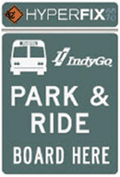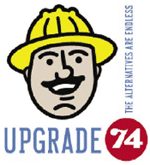Public Information and Outreach Strategies for Work Zones
"Illinois DOT (IDOT) has made a concerted effort to communicate to the public in advance. We've been consistent in our messaging of how important this project is for our future safety and this has really resonated with the public."
– Beth Mosher, IDOT, on the Upgrade 74 project
The Final Rule on Work Zone Safety and Mobility was published on September 9, 2004, in the Federal Register. All state and local governments that receive federal-aid funding are required to comply with the provisions of this rule no later than October 12, 2007.
The rule updates and broadens the former regulation at 23 CFR 630 Subpart J to address more of the current issues affecting work zone safety and mobility. Within the rule are three primary components:
- Implementation of an overall, state-level work zone safety and mobility policy.
- Development and implementation of standard processes and procedures to support policy implementation, including procedures for work zone impacts assessment, analyzing work zone data, training, and process reviews.
- Development and implementation of procedures to assess and manage work zone impacts on individual projects. This includes requirements for identifying significant projects and developing and implementing transportation management plans (TMPs). A significant project is defined in the rule as one that, alone or in combination with other concurrent projects nearby, is anticipated to cause sustained work zone impacts that are greater than what is considered tolerable based on state policy and/or engineering judgment.
The full text of the rule can be found at https://ops.fhwa.dot.gov/wz/docs/wz_final_rule.pdf (PDF, 1KB).
"Because Indiana DOT (INDOT) partnered with the news media throughout the process from the very first day of the closure, we did not experience the gloom and doom gridlock that was feared would have the entire city shut down. People changed their travel behaviors and the overall project was a huge success."
– Roger Manning, INDOT, on the I-65/70 "Hyperfix" reconstruction project
For significant projects, the TMP must include public information and outreach strategies to inform those affected by the project of expected work zone impacts and changing conditions. To assist state and local agencies with these strategies, the Federal Highway Administration (FHWA) is developing a Public Information and Outreach guidance document. This document will include information to help agencies plan and evaluate an outreach campaign; identify the audiences for a campaign; decide when to begin a campaign and what types of information to convey to the public and other audiences and what methods of communication to use; and work with the mass media to spread the message.
This fact sheet provides an introduction to the forthcoming guidance document.
What Is a Public Information and Outreach Campaign?
A public information and outreach campaign involves communicating to road users, the general public, area residents and businesses, and appropriate public entities about a road project, the impacts expected from the project's work zone, and changing conditions on the project. A typical campaign will include traveler information strategies for providing information about what to expect in and around the work zone — such as lane and shoulder closings, new traffic patterns, and traffic delay — and available travel alternatives such as different routes and travel modes.
What Are the Benefits of a Public Information and Outreach Campaign?
Public information campaigns are increasingly being viewed by transportation professionals as an integral part of highway construction programs, large or small.
 |
Park and ride sign for the Hyperfix project on I-65/I-70 in Indianapolis, Indiana |  |
Logo for the reconstruction of I-74 in Peoria, Illinois |
Some of the main benefits of a public information and outreach campaign are:
- Improved driver and worker safety.
- Less traffic delay.
- Reduced driver frustration.
Successful Practices for Effective Public Outreach Campaigns
A review of approximately 30 project-specific work zone public outreach campaigns used around the country found that:
"Overwhelmingly, the reaction from both the target audience and the media to the outreach program has been positive. The Public Information team and the Texas DOT regularly receive positive feedback from the community regarding the regular and timely dissemination of information."
– Raquelle Wooten, TxDOT, on the Katy Freeway reconstruction project
- Successful public information and outreach campaigns are typically planned well in advance of work zone deployment.
- Public information needs can be determined by identifying the scale and patterns of disruption.
- Target audiences are often diverse and may include drivers (private and commercial, local and long distance), residents, employers, other public agencies, organizers of special events, and emergency responders/hospitals.
- A range of communication methods is the best way to reach a diverse audience. Methods may include a Web site, e-mail alerts, printed materials, videos, public meetings, mass media, traveler information, and information centers.
- The underlying messages of most public outreach campaigns are safety first, plan ahead, know your surroundings (delays, change in traffic patterns), and "we care."
- Partnerships with other organizations will help shape and communicate a public outreach message. Other organizations may include public agencies, major employers, and mass media.
- Information should be provided before and during work zone deployment and, in some cases, after completion.
- The strategies used should be evaluated to improve public outreach in the long run.
Implementation Guidance
The Federal Highway Administration (FHWA) is currently developing an Implementation Guidance document to help state and local transportation agencies implement the provisions of the work zone final rule and attain compliance. To supplement the overall Implementation Guidance document, FHWA is also developing a suite of companion guidance documents that will provide more detail on the following aspects of the final rule:
- Work Zone Impacts Assessment
- Work Zone Transportation Management Plans (TMPs)
- Work Zone Public Information and Outreach Strategies
The guidance documents will be available in late 2005 and will provide guidelines and sample approaches for implementing the rule, examples from states using practices that relate to the rule, and sources for more information.
This fact sheet is one in a series of final rule fact sheets meant to increase awareness and understanding of the rule and the products being developed to assist agencies with implementation of the rule. Fact sheets are available for the three specific guidance document topics as well as for the final rule itself.
All final rule resources will be posted to https://ops.fhwa.dot.gov/wz/ resources/final_rule.htm as they become available.
21st Century Operations Using 21st Century Technologies
![]() You will need the Adobe Acrobat Reader to view the PDFs on this page.
You will need the Adobe Acrobat Reader to view the PDFs on this page.
U.S. Department of Transportation
Federal Highway Administration
Office of Transportation Operations
Room 3408
400 Seventh Street, SW
Washington, DC 20590
Toll-Free Help Line: (866) 367-7487
Telephone: (202) 366-1993
Fax: (202) 366-3225
Web: www.fhwa.dot.gov/workzones
FHWA-HOP-05-021
